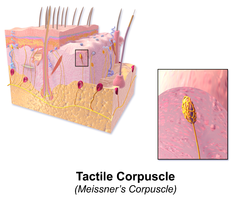Tactile corpuscle
| Tactile corpuscle | |
|---|---|
 |
|

Papilla of the hand. Magnified 350 times.
|
|
| Details | |
| Identifiers | |
| Latin | corpusculum tactus |
| MeSH | A08.800.550.700.500 |
| Code | TH H3.11.06.0.00007 |
| Dorlands /Elsevier |
12261393 |
|
Anatomical terminology
[]
|
|
Tactile corpuscles (or Meissner's corpuscles) are a type of mechanoreceptor. They are a type of nerve ending in the skin that is responsible for sensitivity to light touch. In particular, they have highest sensitivity (lowest threshold) when sensing vibrations between 10 and 50 Hertz. They are rapidly adaptive receptors. They are most concentrated in thick hairless skin, especially at the finger pads.
They are distributed on various areas of the skin, but concentrated in areas especially sensitive to light touch, such as the fingers and lips. More specifically, they are primarily located in glabrous skin just beneath the epidermis within the dermal papillae.
Tactile corpuscles are encapsulated unmyelinated nerve endings, which consist of flattened supportive cells arranged as horizontal lamellae surrounded by a connective tissue capsule. The corpuscle is between 30-140 μm in length and 40-60 μm in diameter.
A single nerve fiber meanders between the lamellae and throughout the corpuscle.
The number of tactile corpuscles per square millimeter of human skin on the fingertips drops fourfold between the ages of 12 and 50. The rate at which they are lost correlates well with the age-related loss in touch sensitivity for small probes (Thornbury and Mistretta, 1981).
Tactile corpuscles are rapidly adapting mechanoreceptors. They are sensitive to shape and textural changes in exploratory and discriminatory touch. Their acute sensitivity provides the neural basis for reading Braille text. Because of their superficial location in the dermis, these corpuscles are particularly sensitive to touch and vibrations, but for the same reasons, they are limited in their detection because they can only signal that something is touching the skin.
Any physical deformation in the corpuscle will cause an action potential in the nerve. Since they are rapidly adapting or phasic, the action potentials generated quickly decrease and eventually cease (this is the reason one stops "feeling" one's clothes).
...
Wikipedia
